Konsalik stacks
2012

from left to right: “Die Verdammten der Taiga” “Eine glückliche Ehe” “Liebe ist stärker als der Tod”

“Die Verdammten der Taiga”

“Liebe ist stärker als der Tod” (in background Mona Jas – Dinge)

“Eine glückliche Ehe” (Detail)
Raplapla
2011Proposal
Competition Neons FMAC Geneve

The concept of the piece is to combines the word with a specific font (Museo Sans) and a visual appearance that supports the word in its meaning. And on the other hand makes absolutely clear that this word is not an commercial advertising.
The support and the difference is the light level spread out by the piece. While an advertising is normally as bright as possible this piece isn’t. The meaning to be completely “mou” or “á plat” forces the sign to glow on a minimal – but viewable – level.
By installing only one strip of neon inside the letters (normally 2-3 lines) the piece will be on a reasonable visibility level during the night, but will never compete with the other signs installed around the Plaine de Plainpalais.
The simple and beautiful word seems to come directly out of a comic in its onomatopoeic
form – but is in fact much older. The oldest source in literature (according to “le Trésor de la Langue Française”) is the book ” Ces bons docteurs!” written by Gyp (Sibylle Gabrielle Marie Antoinette Riqueti de Mirabeau) in 1892.

SG / SD
2010Soundinstallation
in collaboration with Zeena Parkins

In a first collaboration New York composer and multi-insturmentalist Zeena Parkins and Berlin artist Holger Friese present the new sound based installation SG / SD. The project offers a reflection on Kristallnacht: the night of broken glass, Nov 9th 1938. The horrific actions of this night, marked the beginning of the systematic persecution of the Jewish community.
The project offers a reflection on Kristallnacht: the night of broken glass, Nov 9th 1938. The horrific actions of this night, marked the beginning of the systematic persecution of the Jewish community in Germany and Austria.
The focal point of the installation is a vinyl recording produced by the artists.
Side A: Ekhe? a sonic meditation by Zeena Parkins based on field recordings made during a trip to Berlin in Spring, 2010. Zeena recorded sites in the city where in 1938 synagogues once stood, marking the existence of a vibrant Jewish community. Synagogues burned down during Kristallnacht and demolished in the years after, are now often occupied with a very different kind of life: Parking structures, playgrounds. apartment buildings, grocery stores. Seventy two years later, most synagogues are gone, with only memorial plates, to save them from total obscurity.
The acoustic presence of the original site is now disfigured or rearranged. Does some identifying sonic molecule hang stubbornly in the air, defying time and these horrific acts of violence? Perhaps there is nothing more than a simple and brutal non-existence that permeates this absence. Zeena Parkins investigates and reflects upon the acoustic traces of some of these synagogues destroyed on Kristallnacht. All that is left are the most ordinary city sounds of 21st Century Berlin, in which Zeena seeks to unearth the sonic ghosts: an echo, a memory, a deliberate reverberation, to this terriflying night.
Side B: 13 soundfiles cut as loops; Sine waves, gradually stepping up from 3300 Hz to 4500 Hz, each file represents one year of the Nazi regime (1933 – 1945). Holger Friese installs13 manipulated smoke detectors under the ceiling that are triggered by the movement of the visitors in the room. These disturbance tones make an unconvenient overlay to Zeena Parkins’ composition. The sonic short notices reflects behaviour of German bystanders during this night of destruction. The malicious arson carried out by SA/SS members was accompanied by clapping hands and a cheering crowd.
The almost empty main gallery room pushes the vistors into a dense and sometimes disturbing sound experience. Emptiness means here, the possibility of space and time for a reflection about the pogrom night.
In the small gallery room the needed technial equipment is visible.
14 record players in one row with endless spinning records – 13 at a speed of 33 rpm and one with 45 rpm.
Here we have come full circle with the representation of a roll call performed by second hand „soldiers“ bought on ebay.
microscope views vinyldisk

fieldrecordings






video
o.t. – cuelist 1.txt
2009Lightanimation for one 100W bulb (divided one minute with the golden ratio) – Sololala Festival Berlin

stage with bulb matrix (photo: Gregor Holtz)
Open call from Rut Waldeyer and Florian Bach via LCedit mailinglist
concept:
In frame of the the Sololala Festival which will happen from the 2nd to 6th december in the Sopiensaele in Berlin, we are planning to call Lanbox user around the world to a light design contribution for our 64 Solo Bulb Matrix.
The Sololala Festival will present 5 Saxophonists (Evan Parker, Joe McPhee, Thomas Ankersmith, Antoine Chessex,…) and 5 Works of Alvin Lucier performed by Antonia Baehr, Fernanda Farah, Yvonne Harder, Adeline Rosenstein and Steffi Weismann, every evening a double feature of performance and solo saxophone.
As a light design for the whole festival we will us an object hanged over the stage made out of 8×8 100w standard E27 bulbs organised in a 5 x 5 m square grid.
We would like to call the Lanbox user’s to take part to this project by writing a solo for one bulb. Please send us a 1 channel Cuelist up to maximum 98 steps.
Only one limitation is asked: the bulb intensity mus’nt be higher than 70% (180 in 16bits).
Time and action are completely free.
other participants:
Peter Freeman (UK), Jan Fedinger (FI/NL), Maika Knoblich (D), Jan van Giesel (B), Conrad Noack (D), Mona Jas (D), Bruno Pocheron (D), Florian Bach & Rut Waldeyer (D)
SW – Reprise
2009Dummy Head Recording
in collaboration with Mona Jas
produced for the exhibition “Zeigen” – curated by Karin Sander

Recording at Temporäre Kunsthalle Berlin
Produziert für die Ausstellung „Zeigen“ in der temporären Kunsthalle Berlin. Die Arbeit basiert auf dem Konzept der Videoarbeit „Schwarz und Weiß“. In einer räumlichen Kunstkopfaufnahme werden die in der Originalarbeit nicht hörbaren Sätze „Alles ist Weiß“ „Alles ist Schwarz“ durch 20 Sprecher in ihren Muttersprachen (Russisch, Amharisch, Französisch, Deutsch, Türkisch, Hebräisch, Englisch, Dari und Mandarin) gesprochen.
with:
Lilia Voronkova, Oleg Pachenkov, Seyoum Mulugeta, Carine Moulun, Christoph Wiesner, Nesrin Abdulla, Salahaddin Abdulla, Mona Jas, Holger Friese, Gülten Erol, Habip Karatas, Barak Bar-Am, Alona Rudnev, April Elisabeth Lamm, Nick Crowe, Nuschin Mameghanian-Prenzlow, Özgür Albayrak, Hui Zhang, Fei Shan.



Les mèches en ligne
2009in collaboration with Mona Jas
DV-Video presented as a “virus” in the public WLAN / intervention on public ground
Farbig gesprühte Kreise auf dem Boden der Straßen und Gehwege markieren in der Bieler Innenstadt von der Eröffnung der Ausstellung UTOPICS im August 09 bis Ende Oktober neue Territorien, innerhalb deren unser Film “Les mèches en ligne” zu sehen ist.
Die Kreise kündigen jedoch keine zukünftigen Bauvorhaben an, sie sind zeichnerische Interventionen. Sie markieren die Bereiche, in denen BesucherInnen der 11. schweizerischen Skulpturenausstellung einen Film von Mona Jas und Holger Friese im offenen WLAN empfangen können. Das offene WLAN in Biel ist – auf der technischen Ebene – in eben diese verschiedenen territorialen Zonen aufgeteilt. Diese Zonen sind normalerweise unsichtbar, sie bestehen aus elektromagnetischen Wellen.
Vom Zentrum der Sende/Empfangsantenne aus werfen sie einen unsichtbaren Kreis, der mit zunehmenden Abstand schwächer wird und irgendwo abreißt. Die Protagonisten des Videofilms sind, im übertragenen Sinne, auch Zentren der öffentlichen Kommunikation.
Wir haben Friseursalons außerhalb der Hotspots ausfindig gemacht und lassen uns in diesen unterschiedlichen Salons am Rand der neustrukturierten Innenstadt vor laufender Kamera die Haare schneiden. Die gewählten FriseurInnen betrachten wir als urbane Experten, an deren Erfahrungsschatz wir teilhaben möchten. Auch referieren wir auf die generelle Funktion von FriseurInnen als GeschichtenerzählerInnen, möglicherweise als letzte VertreterInnen einer aussterbenden oralen Tradition. In unserem Projekt „Les mèches en ligne“ fokussieren wir daher gezielt Salons mit einem gewachsenen Kundenstamm. Somit beziehen wir uns auf die Figur des klassischen Friseurs als Zuhörer und Erzähler.
Im Gespräch möchten wir herausfinden, wie die Menschen der jeweiligen Bieler Viertel die Veränderungen der Stadt wahrnehmen und, wie sich ihr Alltag dadurch modifiziert. Sichtbar wird dieser so produzierte Film direkt nach dem Starten des Webbrowsers in einer der Zonen.
Der Film ist auf der Loginseite als Overlay zu sehen. Nur wer sich in einer der markierten Zonen einloggt, hat die Möglichkeit den Film zu betrachten. Somit werden die unsichtbaren Funk-Territorien des WLAN zur Erfahrung und die Protagonisten des Films besetzen die virtuellen Territorien mit Geschichten aus den Straßenzügen, die sich um das Zentrum herum ereignen.
Produktion: Utopics
„Clash Hairstyle“ mit Michael Jalon, in „Coiffeur Tania“ mit Tania Santulli, im „Coiffeur Sporting“ mit Pino Margarito und in „Miss Ivoire“ mit Raymonde Grah-Meusy.
images taken during our reseach april 2009
Article Berner Zeitung
Article Berner Tagblatt
TV feature SF1
map with marked hotspots

wiping away the chalk used to draw the circles


Installationviews
THE INFLATED PUMPSTATION
2008
The proposal takes the term “second skin” very literally. I propose to attach a structure to all walls that holds – in a defined distance – a duplicate of the given architectural structure. This second layer around the building is made out of latex (or another highly flexible material). All doors, windows and gates are cut out and stay fully functional. Air will be blown in the space between the concrete walls and the second layer. The latex skin will inflated and the complete building will change dramatically. The perpendicular structure will transform into something more natural. The air will find its way to large areas that will inflate to large bumps and smaller areas that will only get out of square. The building that is visible for the neighbors and passer-by since many years will be transformed into something new and spectacular.
The flexible skin that can act or interact with the work of the pumps inside. A connection between the water flow rate and the pressure of the balloon skin is one option. Or the building can breathe and pretend to be alive. Or a combination of both: The building breathes faster or slower in connection with the water flow rate. The more the pumps are forced to work, the heavier the house must breathe.
To avoid the connotation of a fat house – aka to transform the building into something human – the color of the skin is important. The pink selected for the model seems to be a good choice, it gives the alien touch – with no chance for misinterpretations.
model inflated by human breath
competition website
download presentation boards (PDF) english 11 MB
download Dawntown Briefing (PDF) english 4 MB
Erwin Wurm’s Fat House
Article Miami Herald
Images model








see breathing movie (Mp4 3MB)
Images building


SIGNALISATION
2008
A sign that tells you it’s a sign. The signal send from this advertisement to the receiver is useless, the message has no novelty. The artist did steal the novelty by choosing the term. As an advertising object this object must fail – because the “message” is missing. It only superimposes the fact that we are surrounded by signs, regardless if we like them – or even if we want to see them.
During the day (when the piece is off) the letters will reflect the sky and can be seen as an discrete object of beauty. Not a crying sign in aggressive colours, not a technical neon object with a sometimes ugly visible metal supporting structure. Just a mirror of the sky with the possibility to see a the reflection of a bird or a plane passing by.
After sundown the internal white neon elements will be switched on. Thus the mirror used for the screen is semi transparent the emitted light will be visible. Eleven bright letters on top of a building, still without a novelty. Only the car driver – standing at a red traffic light – gets the useless information “Yes, we do have traffic lights in Geneva”.
But on the right hand side a cryptical fr | it | de | rm | en sign also illuminates. After a while four of those letter combinations goes off and the big letters start to do something – a communication process starts.
Words in French, Italian, German, Rhaeto-Romanic and English are displayed. The four official swiss languages and for the tourists English. The silly word “SIGNALISATION” mutates to – NATION – SANG – SAAT – STILLATION – LAIN – STAGNO – SALAT – ALATO – STILL – SINON – SALIT. The attached language indicator helps the viewer to read the words. The partly visible advertisement now distributes novelties.
The display of words follows a system. First on display are all words contained in the french term “SIGNALISATION”. After a short pause a selection of words will be displayed that start with the letter “S” and can be written with the available letters.
Those words must be recombined by the viewer. To support the viewer the sections – if possible in syllables – are joined with a dissolve between the sections / single letters.
If the viewer miss it – or simply doesn’t understand the language – the sign acts as a sick sign. For example the french word SANG – blood is displayed in two sections “SAN” followed by a single “G”. The sign will look like the letters are going mad, which is an effect that might also be intended.
The languages are separated by moments of “silence”, where the viewer can only read the term signalisation. The complete loop over all languages will have a duration of 30 minutes and will repeat till sunset.
download proposal (PDF) english
Animation stills



see movie (Mp4 4MB)
Detail – language indicator
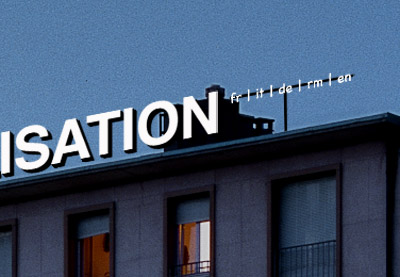
SIGNALISATION

MAINE BILDER TANKS
2008
Each tank will be transformed into a canvas, which will host a portrait image of a well-known personality. The image will not be painted in a photorealistic manner; it will be stripped down to a fairly abstract level. In four quadrants around the tank one is able to see the same image in four different image resolutions.
Referring to digital images, which are always based on pixels (aka Picture element – the smallest unit of a digital image, it holds only one color value in a square) the surface of the tanks will be divided into a grid of squares.
The four stages will show an evolving series starting in the quality of a color field painting, progressing to the status of a passerby stating, “This must be a portrait.“ and ending at a resolution where one can identify the name of the person.
The last two stages are based on two parameters. The first is given by the location. The viewer is able the see the tanks from rather far distances. The second is based on the original image material – carefully selected by the artist. The images are part of the American „collective image memory“ and therefore it is possible to recombine the image from the seen squares and the images „stored“ in the brain of the viewer.
The system of four stages per personality only works as a concept for the sides of the tanks. The tops, which can be seen best from an airplane or in digital via Google Earth will be treated in a slightly different form. The tank tops are divided into groups and the personality spreads out over one to four physical objects. In this way, the images of faces will come into focus from a bird’s eye view.
List of portraits:
tank #42 Samantha Smith
tank #118 Leon Leonwood Bean
tank #13 Harriet Tubman
tank 14 Benjamin Franklin
tank #105 Martin Luther King
tank #5 Thomas Edison
tank #28 Amelia Earhart
tank #111 Susan B. Anthony
tank #42 Milton Bradley
tank #118 Molly Spotted Elk
tanks #13, #14, #105 EB White
tanks #112, #113, #114, #207 Rosa Parks
tanks #102, #103, #101 Harriet Beecher Stove
tanks #111, #28, #5, #4 Marsden Hartley
Competition website http://www.artallaround.com
Maine Center for Creativity http://www.mainecenterforcreativity.org
plan for tank #105
location at Google Maps
and the winner is…
Test with projector

Overview

Sprague Energy Corporation overview
Proposal images

proposal view B (full scale)
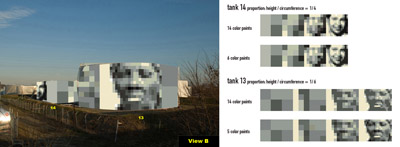
proposal view B (full scale)

proposal view C (full scale)

proposal view D (full scale)
Schwarz und Weiß
2007
The project for the Axel-Springer-building in Berlin is based on images of talking mouths. On the screen on top of the tower block, two mouths can be seen from the distance. After a while it is easy to discern what they are pronouncing, even though it is inaudible – they say "everything is white" and "everything is black". These contradictory statements are spoken by two mouths directly next to each other, in a continuous sequence: first a woman says, "everything is white", next to a man who says, "everything is black"; then there is a change, and the woman says, "everything is black", while the man says, "everything is white". The film shows a part of the faces, but focuses on the talking mouths, and thus the information about gender and race of the speakers remains transparent.
The words can be ‘seen’ in nine different languages: Amharic (Ethiopia), Russian (Russia), French (France), Arab (Morocco), German (Germany), Turkish (Turkey), Hebrew (Israel), English (New Zealand/UK), Dari (Afghanistan) and Mandarin (China). In each case, the two people are native speakers of either sex. Each language has a time frame of about 30 seconds. The movements of the lips and mouths are so clear and concise that each viewer of the same linguistic area can easily perceive the statements.
The fact that the language cannot be heard and the process of speaking is ‘only’ seen incites the viewers’ curiosity and they want to know, what is hidden behind this film. Thus, the usual communication structures are prised open, and through the simplicity of the piece’s conception, the viewers are at liberty to fill them with meaning of their own, with their own thoughts and feelings.
Shown on a prominent and widely visible press building in Berlin, the piece also refers to the necessity for truth in the news industry. It is a contemporary urge to prove the truth with facts, and the contradictory statements – "everything is white" and "everything is black" – create irritation and are open to a wide variety of associations. One can surely associate the conclusive "in black and white" of the printed media. Yet, other points of reference could be various political disputes. In the complex conflicts of the Near East for example, it is difficult to say, whose record is all white and clean.
3 films (2016 x 160 px), durations: 01:29 min, 01:40 min, 01:28 min
Location: Axel-Springer-Building, Berlin – until 30.11.2007
Curated by Annika von Taube / sleek magazine
download (PDF) german
press release Sleek magazine (PDF) german
Images / Films
![]()
![]()
![]()
stills film1 / see wmv (8,7 MB)
![]()
![]()
![]()
![]()
stills film2 / see wmv (11,5 MB)
![]()
![]()
![]()
stills film3 / see wmv (8,8 MB)
Classici
2007
The project “Classici” for the Palazzo delle Esposizioni in Rome combines two opposing parts. The first part is the existing neo-classicist architecture. The second is the artistic interference, a series of – at first sight – disturbingly kitschy photomurals from Germany.
The photomurals is to be temporarily applied with paste on the finery of eight coffers of the facade. In order to make the wallpaper visible at night, these will be illuminated with floodlights. Thus the purely structural elements of the facade are transformed into windows. For the audience, they present a view on emotionally charged landscapes of desire. The subjects of these photomurals range from a sunset at a beach in the Pacific to an autumnal forest, from Neuschwanstein Palace in Bavaria to the skyline of Manhattan.
The motives of these photo wallpapers, which measure up to 270 x 380 cm, are extracted from their decorative usage in domestic interiors and placed as a disposition in the public realm. They refer to the human longing for a perfect world, the desires for exotic escapes and a seemingly better life far away. In their provocative transposition “outdoors”, on a representative building, they question the original concept of the Architecture.
The Palazzo delle Esposizioni was built in 1883, in the neo-classicist style that was the contemporary design of choice for a representative building of the dominant political power in Europe and the US. At its centre is the entrance in the form of a triumphal arc that can be accessed via a flight of steps. The stylistic idiom is taken from antiquity and stands for rationality and clarity. At the same time, this invocation of antiquity and its aesthetics positions this far from the social reality of the day and keeps visitors at a respectful distance.
Like with all neo-classicist buildings, the architecture is appropriating elements from antiquity, without ever achieving its authentic harmony and beauty. Thus, this Palazzo embodies a longing. This longing, however, is not directed to the future, as are the photomuralss, but to the past. This double longing between the building and the applied wallpapers becomes apparent for the viewing citizens. The monumental architecture of representation of the central tract is flanked and countered by the modest longings of the individual citizens.
For two days and nights, the project “Classici” makes it possible for citizens and state to rub against each other on the outer skin of a building. The term ‘classici’ is Latin and means “citizens of first tax bracket”. The derivatives “classical period” and “classicist” are synonyms for the exemplary and commendable. With this title, we would like to accentuate the common striving for the unattainable. For us Germans, Italy was always the location of an imagined paradise, the “country, where the lemons are flowering”. At present, people illustrate this longing through holiday photographs and standardized posters of these “paradises”, which are attached in domestic spaces for constant viewing.
The longing, backward looking face of the Palazzo’s representative architecture will thus fuse with the individuals’ private longings for another location, creating a varied and colourful view.
Curator: Camilla Pignatti Morano
Manufacturer of photomurals Komar
Homepage Palazzo delle Esposizioni
Homepage Deutsches Tapetenmuseum
Selection of Photomurals
Photomurals New York
www.antworten.de (Buchhalter)
2007
Der gezeigte Bücherhalter vereint 3 Elemente, die sich alle auf die Netzarbeit "www.antworten.de" 1997 Holger Friese & Max Kossatz beziehen. Das horizontale Stück Holz kann als Entwicklungsachse gelesen werden.
Die Idee zu "www.antworten.de" entstand in New York bei Russ & Daughters, Einem "Appetizer" Geschaft in der Lower East Side. Beim Betreten den Geschäftes muss der Kunde eine Nummernkarte ziehen und auf seinen Aufruf auf einem Display warten. In dieser Wartesituation entstand die Idee zu "www.antworten.de".
An der Stirnkante sind mittels einer Büroklammer 2 Fotos angebracht. Sie zeigen zwei Innenansichten von Russ & Daughters. Auf einem der Fotos ist ein rotes Plastikgehäuse zu sehen, dem Spender der Wartenummern. Auf dem zweiten Foto ist auf der rechen Seite unscharf im Hintergrund die zweistellige Digitalanzeige zu erkennen,
Das Display auf der Website ist an das Original Display angelehnt. Wir haben damals Bagel, Caviar Creamchesse und Lachs eingekauft.
Die Internetarbeit wurde im Anschluß an den Einkauf binnen weniger Stunden programmiert und online gestellt. Hinter den Fotos ist leise die Originaltonschleife der Website zu hören.
2004 wurde die Idee geboren die flüchtige Netzarbeit in Buchform zu konservieren. Zwei Jahre später erschien das Buch im Verlag "The Greenbox".
Altholz, MP3 Player, 2 Fotos 9x12cm , Buch
see also: www.antworten.de, 1997
www.antworten.de, artistbook, 2006
Images:

Russ & Daughters, NYC (Display on right hand side)
copyright: "Paul_S" (found at www.flickr.com)

Russ & Daughters, NYC
copyright: "I_like" (found at www.flickr.com)
search for more images at flickr
www.antworten.de (Book)
2006
The website www.antworten.de – a pioneering work of net.art, and the first Internet artwork to be sold in Germany – is transitory. This work, conceived by Holger Friese and programmed in collaboration with Max Kossatz, could one day – when new programming standards emerge or the Internet disappears – no longer be available; data will then be lost or no longer readable with existing programs.
This book aims to redress the problem. In the traditional and durable form of printing, the website’s program is now published and annotated. Each image, each code from www.antworten.de is presented in digital form, as a notation of the programming sequences. Furthermore, each separate part is described so that a future programmer could reproduce the work with an identical surface. The short melody is written in notes; the colouration of the countdown digits is captured pixel for pixel.
www.antworten.de is an analogue conversion of the website www.antworten.de thus making the web-art of www.antworten.de for the first time fully virtual. The work becomes a thought-game that (almost) anyone can reproduce. The documentation finally makes clear what constitutes this work; the focus is on the mediality and functionality of the individual parts.
Publisher: The Green Box
Holger Friese & Max Kossatz
www.antworten.de
96 pages, ca. 20 Abb.
165 x 200 mm
soft cover, thread-stitching
German
ISBN 3-908175-15-1
download sample (PDF) german
weblog Max Kossatz
see also: www.antworten.de, 1997
www.antworten.de, Buchhalter, 2006
19991 – Home delivery
2005
In the uncut 17-minute version, the film shows events in front of the McDonald’s in the Hadaba section of Sharm El-Sheikh on the Sinai peninsula. The film was made two days before the bomb attacks in July 2005.
The managers of the American McDonald’s chain developed a sales strategy of transparency in the mode of production and in hygiene, as well as of the economically efficient (because it increases sales) self-service as the trademark of their company. In this regard, their branch in Hadaba – in an inconspicuous twostory building with closed shutters – can almost not be identified as a McDonald’s.
The fast food restaurant is hidden, earning its profits solely with home delivery, i.e. the opposite of self-service. The only identifier of American gastronomy is the McDonald’s logo on the trash cans, which are visited by roaming animals, and on the advertising spaces on the delivery boxes attached to the company’s Vespas. An employee wearing a traditional Djellaba, probably the building custodian, leaves the house several times and then comes back. In the courtyard, he carries out the ritual cleansing before going to the mosque. A young employee wearing a McDonald’s uniform leisurely prepares his departure, obviously to deliver a freshly prepared order. The Vespa is ready to go after several start attempts. Then he polishes his helmet and cleans his vehicle to free it from the desert sand. Finally, he drives away.
We notice that the paths of the two employees cross several times without them making eye contact. Animals continuously run to and fro in front of the building. Taxis, a tourist bus and other cars cross the screen. Various pedestrians, some of them on the way to the mosque on the other side of the street, pass by. The muezzin from the mosque (which is beyond our view) can be heard calling to the fourth of the five daily prayers.
Independent of this and acoustically separate, the soundtrack “Mix” can be heard via a remote headset for somewhat over 15 minutes. For 14 minutes, actress Megan Gay reads aloud various informational texts and advertisements from tourist brochures about Sharm El-Sheik. In the final minute, a song from the Egyptian mizmar baladi ensemble can be heard.
A further element is a tower of three stacked stones on the floor of the exhibition space. In the Sinai Desert, such towers mark the junctions for the residences of the Bedouin families that establish themselves there. The stones in the exhibition come from Europe because Egypt has a general export prohibition not only for shells and corals, but also for stones and sand.
two documents on wikipedia about Adhan and Salah
Still images



see film (excerpt 5min – mp4)
Stonetower

Photographs


The 16bit library
2005
Die Universität, als Institution der Wissensvermittlung und -vermehrung, ist ein Ort der Lehre und des Studiums, der Forschung und der Kontemplation. Hort des Wissens ist hierbei die Bibliothek; sie ist das zentrale Archiv, das die derzeitigen und vorangegangenen Wissensstände versammelt und sie zugänglich macht. An keinem Ort wird die Vermittlung von Wissen so anschaulich wie hier; die Arbeitsplätze zwischen den Regalen dienen der Aneignung der in den Beständen enthaltenen Informationen und über die Ausleihzentrale verbreiten sich die Bücher an die Forschenden in der ganzen Region.
Messbarer Moment der Wissensvermittlung ist die Ausleihe eines Mediums aus der Bibliothek. Mit the 16bit library von Holger Friese zieht der reine Verwaltungsakt der Verbuchung einer jeden Ausleihe nun auch eine für die Benutzer nicht unmittelbar sichtbare Veränderung am System nach sich. Jede einzelne Ausleihe wird dabei als graduelle Farbveränderung visualisiert, die über das Internet von jedem Ort des world wide web verfolgt werden kann. In der Bibliothek selbst verändert sich im Raum 611 auf Ebene S6 die Farbe des Umgebungslichts. Der Raum wird durch 16 RGB-Systeme beleuchtet, die gemeinsam gesteuert jeweils unterschiedliche Anteile roten, grünen und blauen Lichtes abstrahlen (entsprechend den einzelnen Bildpunkten eines Bildschirms). Die Mischung dieser Farbanteile ergibt die Farbigkeit des Lichts, und im Raum, der mit allen Möbeln, den Wand- und Bodenflächen ganz in weiß gehalten ist, ergibt sich daraus eine äußerst intensive Farberfahrung. Durch die Fenster dringt dieses Licht auch in den Außenraum der Universität und
ist dort je nach Helligkeit des Tageslichtes als gerade noch wahrnehmbarer Schimmer zu sehen oder als ein gleißend farbiges Leuchten.
Documentation webserver www.16bitlibrary.org
Proposals 1st & 2nd stage
unrealised part: redesign
Lightanimation 32.768 steps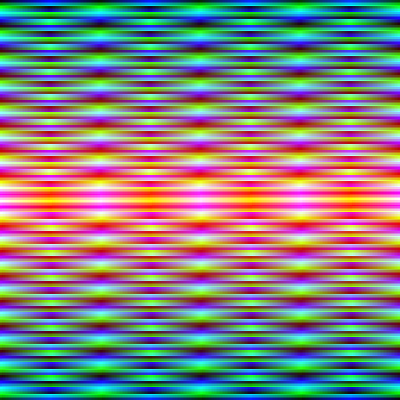
Installation process
Before Installation
RGB lighting systems installed
Walls and Floor finished
Desks
Zeichen/Sign
2004
Zeichen nimmt die Form des ehemaligen „Hammer und Zirkel“ Symbols an der Fassade des Palastes der Republik wieder auf. Es umschreibt die Fläche dieser Markierung mit einem Kreis weißer Neonröhren und wird dadurch selbst zu einem deutlich sichtbaren Zeichen. Gleichzeitig lenkt es natürlich die Aufmerksamkeit auf eine ideologische Leerstelle; es zeigt auf, wie der Palast der Republik durch die Entkernung zu einem Freiraum in der Stadt wurde.
Zeichen funktioniert aber auch als Symbol der Neunutzung, der kulturellen Umnutzung des Leerstands. Es machte weithin deutlich, dass an dieser Stelle Neues geschieht, dass die Kultur den Palast neu belebt.
Axel Lapp
Construction of Neon

GDR emblem / cutting points

Neon elements
Postcards
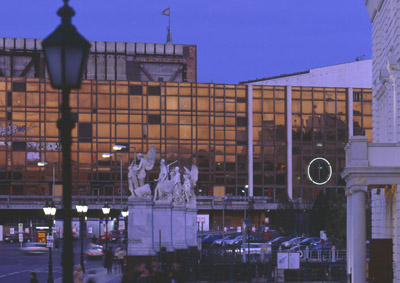
Postcard produced for Volkspalast
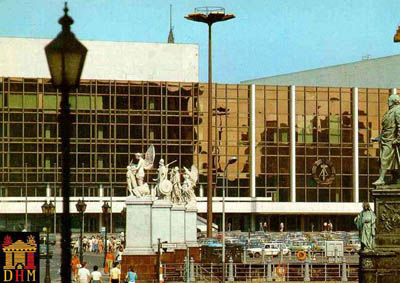
GDR postcard ca 1970 (Deutsches Historisches Museum)
Non authorized uses

Sign/Zeichen during concert “Einstürzende Neubauten”

Sign/Zeichen during BC one (Red Bull)

Sign/Zeichen as part of a poster at Volksbühne, Berlin
Alle Dinge die Christian Schimanski…
2003 - ongoing
The movie “All items auctioned by Christian Schimanski over the internet in the last xxx years” presents items who had been sold or bought by a user named “schimanski.net” on ebay. The slideshow of goods presents a deep view into the private life of a specific person.
We are tracing the user schimanski.net since more then eight years – collecting everything he did sell or buy on ebay. Each transaction prolongs the movie.
ebay user schimanski.net
see movie
Still images





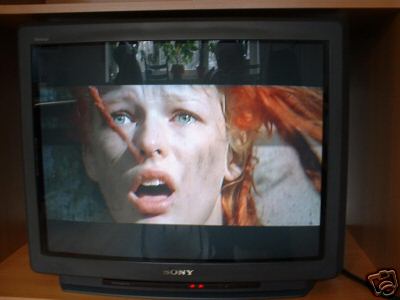

Shrink to fit
2001
Arthur Kroker once warned us of the “will to virtuality.” Karl Marx’s famous line from the communist manifesto “all that is solid melts into air” was stock in trade of the post-modern critic for the better part of the last decade. Gilder, on the other side of the political spectrum, declared the “overthrow of matter” the most significant event of the 20th century. Atoms seemed so passé. Early on net.art also ventured into the realm of pure virtuality, letting loose, and getting lost in, the mirror cabinets and shadow worlds of code. Leading the way into infinite loops and labyrinths was the fearless crew of jodi.org. Another explorer, Vuk Cosic, evaporated the entire history of art into ASCII, or at least he showed how it could be done by anyone sufficiently interested in comprehensiveness.
This was netculture’s heroic period, indeed.A few years and few sobering experiences later, our path into cyberspace no longer seems a one way street. Despite uncounted, uncountable hours immersed in the electronic data flows we have not left the body behind, rather, we acquired repetitive strain injuries in our wrists and elbows and a heightened sensitivity for the quality gradings of office furniture.
There is now, one could say, a renewed appreciation of materiality. However, this is not a simple return to the status quo ante. Materiality and virtuality are forever intertwined. Day and night, dreaming and waking. One mirrors the other. Two halves that make one whole, sometimes less, sometimes more. The Internet is not the terminal point of an ever increasing virtuality, but an interface to people and things. Like any interface, it has a life of its own but one that would be meaningless without that which it connects. The Internet is a space and, like physical space, it is all about connections, a connections, though, that is organized not geographically but logically.
Holger Friese’s contribution to the Shrink-to-Fit project is a patchwork of different connectivities. The game plan is simple enough. Friese downloads 4 compressed files to the user’s hard disk. Once uncompressed, they turn out to be four artist portraits from a gallery located somewhere online, close-by, the pro-verbal “only one click away”. Logic space at its best, quite normal these days. But that’s not the end, it’s the beginning. The files can be rematerialized thanks to a commercial service that prints photo-files onto paper. Here the virtual and the physical meet closely. The service is one click away, but a few days later, a real postman rings at your front door, hopefully not too early in the morning. However, the physical invades the logical space in the form of fine print. The service is only available in Austria, Germany, Switzerland and Denmark, carving out some arbitrary geographic unit. Moving deeper into domain of the physical, we can also order a frame for our portraits, one that is numbered and signed by Friese himself.
However, for the artist’s Midas touch to work turning a simple frame into unique work of art we have to buy the frame where Friese, who lives in Berlin, can actually touch it.We have come full circle. What started out as anonymous, infinitely repeatable, compressed data-download, hangs now on the wall in our living room, sporting a unique serial number and a signature. It’s almost like in the old times, when art meant physical object made by an artist, if it wasn’t for the heavy pixelation of the print, a reminder of its ever constituent virtuality.
Felix Stalder
“Shrink to fit” was project on X-cult.ch.
Shrink to fit homepages:
http://www.shrink.li/shrink/art/friese/index_e.html(english)
http://www.shrink.li/shrink/art/friese/index_d.html(deutsch)
Galerie Huberti website
Delivered Images

Portrait artist Roland Herbold
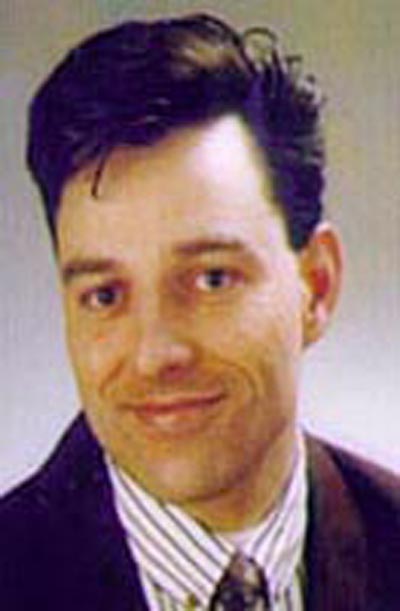
Portrait artist Carsten Fromm

Portrait artist Francoires Legrand

Portrait artist Erika Wörndl

Frame for Portraits
Attention Slippery Data Traffic
2001
Die Aufsteller behalten ihren Zweck, Durchgangsflächen in Räumen für den Besucherverkehr zu sperren. das Absperrband zwischen den einzelnen Schildern wird duch ein Ethernet Kabel ersetzt. Die Absperrung wird am Anfang und Ende mit zwei an den Wänden angebrachen ISDN-Dosen verbunden und kann damit den Eindruck erwecken das Daten durch das Kabel fließen.
www.inmeinernaehe.de (exhibition version)
2000
Wenn man auf das Internetangebot „In meiner Nähe“ stößt, wird man verleitet zu glauben, man befindet sich in einem durchdachten, kommerziellen Shopping System. Nach Eingabe der Postleitzahl und des Wohnortes wirft das System nur WWW-Präsenzen aus, die sich in der näheren Umgebung befinden. Das unüberschaubare, globale Netzwerk wird plötzlich benutzbar und praktisch. Der Getränkeladen mit Lieferservice – der Allgemeinmediziner, der hilfreiche Diät-Tips bereithält – selbst eine seriöse Begleitagentur, ein Rechtsanwalt oder der Klempner sind für den Fall der Fälle erreichbar.
Auf den zweiten Blick fällt jedoch auf, daß auf keiner Homepage eine Telefonummer oder eine komplette Anschrift verfügbar ist. Und nach dem Klick auf das Bild des Diplom-Übersetzers Thorsten Strömer, werden nicht weitere Informationen zur dieser Person auf dem Bildschirm sichtbar, sondern aus Herrn Strömer wird Herr Einstein, der sich als Nachhilfelehrer für die Fächer Mathematik und Deutsch anbietet.
Gleiche Bilder, verschiedene Menschen, die sich durch die falsche Struktur des Systems ergeben. Alle Homepages sind leichte Überarbeitungen, die von der für 49.95 DM käuflich zu erwerbenen CD-ROM „Das große Homepage Paket“ des Softwarehauses Data Becker stammen. Eine CD, die verspricht, binnen 15 Minuten im Baukastensystem eine effektive Internetpräsenz zu erstellen. Herr Strömer ist Herr Einstein ist Herr Gau ist Herr Legrand und doch sind sie alle nur Blindcopys, Platzhalter für „echte“ Fotos.
In der Ausstellung werden die beliebigen Platzhalter zu Bildern – vom Passbild zum Abziehbild. Holger Friese verbindet Herrn Strömer und seine Typoi neu. Sandgestrahlte Glasplatten dienen als Träger der Identitäten, auf die die stark vergrößerten Portraits aus Adhäsionsfolie geklebt werden können.
ot.pdf
2000
Die Idee der Arbeit basiert auf der Form des Katalogs zur Ausstellung BMA 2000 im Neuen Aschaffenburger Kunstverein. Er wurde als BOD (Book on Demand) gefertigt. Dieses Format zeichnet sich durch schnelle Verfügbarkeit und minimale Vorlaufkosten für den Autor und niedrige Produktions- und Lagerhaltungskosten für den Verlag aus, da jedes einzelne Buchexemplar erst nach der Bestellung produziert wird. Die einzige Beschränkung ist, daß die Innenseiten nur schwarz/weiss bedruckt werden können. Die Wandarbeit zeigt einen kleinen Ausschnitt des Sourcecodes eines farbigen Bildes. Über diesen Umweg nicht das Bild sondern die Datei, die das Bild beschreibt im Katalog abzudrucken, ist es dann doch möglich ein farbiges Bild im Katalog zu veröffentlichen.
Reload 2000
2000
Das ursprüngliche Ausstellungskonzept von RELOAD wurde überarbeitet und gestrafft: die raumbezogene Skulptur von Stefan Wieland besteht aus den Buchstaben “F U C K !”, die auf Rollen einzeln bewegt werden können und, wie schon bei früheren RELOAD Ausstellungen, als Benutzeroberfläche für Spieler und Computer dienen. Die Teile können zusammengeschoben werden und bilden dann das Wort “LOST”. Diese Buchstabenobjekte finden sich als bewegliche, virtuelle Architektur in dem Quake 3-level, der von Tom Ehninger, Holger Friese, Christine Meierhofer und NoRoomGallery gemeinsam konzipiert und umgesetzt wurde.
www.inmeinernaehe.de
1999
Das unüberschaubare, globale Netzwerk wird plötzlich benutzbar und praktisch. Der Getränkeladen mit Lieferservice – der Allgemeinmediziner, der hilfreiche Diät-Tips bereithält – selbst eine seriöse Begleitagentur, ein Rechtsanwalt oder der Klempner sind für den Fall der Fälle erreichbar.
Auf den zweiten Blick fällt jedoch auf, daß auf keiner Homepage eine Telefonummer oder eine komplette Anschrift verfügbar ist. Und nach dem Klick auf das Bild des Diplom-Übersetzers Thorsten Strömer, werden nicht weitere Informationen zur dieser Person auf dem Bildschirm sichtbar, sondern aus Herrn Strömer wird Herr Einstein, der sich als Nachhilfelehrer für die Fächer Mathematik und Deutsch anbietet.
Gleiche Bilder, verschiedene Menschen, die sich durch die falsche Struktur des Systems ergeben.
ot.bsp
1999
Im Spiellevel werden die oftmals architektonisch opulenten und mit düsteren Texturen belegten normalen Spiellevel auf einfache, in einem großen leeren Raum schwebende Elemente reduziert. Fast alle Texturen stammen aus seinem privatem Internet – Bildarchiv; somit werden die mystischen, dunklen Räume zu Plattformen die mit Küchenhandtuch-Karo oder Rauhfasertapete belegt sind.
Neben den optischen Veränderungen wird auch tief in die Spielstruktur ein gegriffen. Nicht nur die Mitspieler sind Gegner, sondern manchmal wird das Level selbst zum Feind.
Interview with Martin Berghammer / Videos
Article Berliner Zeitung
www.antworten.de
1997
Die Arbeit www.antworten.de ist ein zuerst einmal sehr einfaches Interface im Internet, der Benutzer wird mit einer Situation konfrontiert die er aus dem täglichen Leben kennt. Er bekommt automatisch eine Wartenummer zugeteilt und wartet bis er an der Reihe ist. Im täglichen Leben – auf dem Amt oder beim Metzger – durchaus sinnvoll, im Netz eher ungewöhnlich, wenn nicht sinnlos.
Die Arbeit erreicht seit dem sie online ist kontinuierlich mehr und mehr Benutzer, zur Zeit etwa monatlich 25.000 Konsumenten. Diese spalten sich in Benutzer und Besucher auf, denn wahrscheinlich wissen 90% der Benutzer nicht, dass sie ein Kunstwerk betrachten. Für die Mehrheit der Benutzer ist Antworten ein glaubhaftes Auskunftssystem und damit nach Ablauf der Warteschleife, die mit dem Überspringen der persönlichen Wartenummer endet, der totale Betrug.
Die Benutzer, die nicht bis zum bitteren Ende ausharren und die eine Möglichkeit der Interaktion, dem Verfassen und Abschicken einer Email an die Adresse fragen@antworten.de, wählen, senden Fragen zu diversen Themenkomplexen ohne damit einen wirklichen Aufschluß zu zu lassen, ob sie nun wirklich an das System glauben, oder den Spielball der Erwartungshaltung elegant zurückspielen. Die Mails decken ein weites Spektrum ab, von der Bitte der Beantwortung von Hausaufgaben von Schülern, über Fragen der praktischen Lebensführung – Steuernsparen, Schuldnerberatung, Liebesleben bis hin zur Ankündigung eines Freitodes.
Diesen glaubenden Benutzern steht die kleine Anzahl der Besucher gegenüber, die entweder wissen, dass es sich um ein Kunstwerk handelt, und deshalb das Spiel mitspielen oder es nicht wissen, den “Betrug” dann aber frühzeitig merken und damit schnell das Interesse verlieren.
Die Künstler haben längst die Möglichkeit der Kontrolle der Rezeption der Arbeit als klassisches “Kunstwerk” verloren und dies auf beiden wichtigen Ebenen. Sie sind in der Mehrzahl mit Benutzern, nicht mit Besuchern, konfrontiert.
Im Besitz der Sammlung Hannelore und Hans Dieter Huber, Stuttgart
Zusammen mit Max Kossatz, Wien
Unendlich, fast…
1995
Ein Frühwerk der “net.art” das in der Kritik zwischen “minimalistischem Meisterwerk”, “Anschlußwerk an Yves Klein” und “dem totalen Blödsinn” besprochen wird.
Es besteht aus einer HTML Seite die so kodiert ist, daß sie viel zu groß ist um ganz gesehen zu werden. Die einzige Möglichkeit sich auf der planen Fläche zu bewegen ist sich mit den Scrollbars des Browserfensters durch das Bild zu bewegen. Es gibt keinen Weg hinein oder hinaus, es gibt nur die Bewegung in der X- und der Y Achse. Am rechten Rand, ein wenig unterhalb der Mitte ist eine kleine Grafikdatei eingesetzt. Auch dieses Bild ist kein Bild im fotografischen Sinne, es ist ein Bildschirmfoto einer Postscript Datei (Der Standardsprache mit der Daten an einen Laserdrucker übermittelt werden). Sterne und Linien die in computerlesbarer Form eine liegende Acht, das Unendlich Zeichen abbilden.
IASLonline Lektionen in NetArt
Monochromacity as a Reflection of Computing Processes in Internet-based Art
THWARTING WEB USERS’ EXPECTATIONS
YouTube

